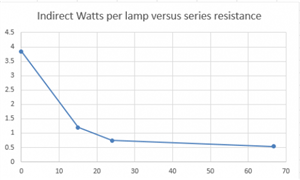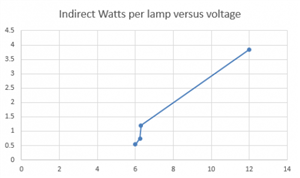As well as an Engineer (admittedly retd), I'm also a motorcyclist. Just decided to try and fit my M/C with some additional lamps so that it shows up better amongst the pretty Christmas trees that are nowadays marketed as four wheeled individual transport. You've probably seen a similar effect on the big chunky crossing-continents style bikes.
(This paragraph is a background rant, skippable) I wanted to achieve something akin to a daylight running light (DRL). However, on looking at what I can buy, there's a problem. It seems aftermarket lamps for motorcycles are generally sold as fog/spot/driving/auxiliary lamps. I mean, the sales blurb claims one lamp is all of those (and more). Which is odd, as the beam pattern (and homologation, where done), of fog and spot lamps is completely different. And indeed regulations limit the use of fog lamps to, err, fog, and I believe the use of spot to with main beam (Although I have also heard that these regs don't actually or entirely apply to M/C - I'm uneasy about that, especially abroad). I think “driving” means same as “spot”, and “auxiliary” means, well, nothing much. In summary, the cheap suppliers were selling snake oil, and the expensive suppliers sold homologated lamps for use in fog or with main beam. Spot type lamps are also especially useless to me, as my bike's LED dipped beam is quite visible over a narrow angle, but very weakly visible off centre, I want a wide spread.
So, I bought two general purpose 10W each, 12V packaged vehicle LEDs, sold as much for off roaders or lighting load areas. A garage test shows a nice wide, unfocussed, spread. I think they will be very visible in the day, over a wide angle, and at night on dark roads (with main beam), will help illuminate around bends.
But, I'm concerned that at night in busier areas, they may be too bright and dazzle other drivers, or cause unwanted aggravation. So, I'm wondering about a dimming arrangement, so I can manually dim them, and, hopefully, override that with the high beam.
I am not assuming they'd behave in a simple linear(ish) fashion like an incandescent bulb, but have nothing else to work on. They might even be smart enough to maintain full output at much lower supply voltage. They might really dislike being fed PWM. I don't want to try to dismantle them to find out (cheapskate only bought 2), as they will really need their weatherproofing. Anyone know what circuitry might be typical in such products?
Thought A was to switch them between normal parallel connection and series, with a switch and mainbeam driving a DPDT relay through diode OR logic. However, it gives no real design choice of how dim - probably too dim, 6V may not be enough to operate (or reliably). And it seems the automotive industry doesn't offer DPDT relays in “outdoor” packaging with spade terminals (only SPDT).
Thought B was to put in a series resistor, shorted by a SPST relay, switched as above. But the resistor would have to be pretty chunky, and get hot, so presents a bit of a packaging problem on a modern M/C, with every crevice rammed with pipes, wires & boxes.
Any guidance or tips'n'tricks on these sort of packaged LED products appreciated?

